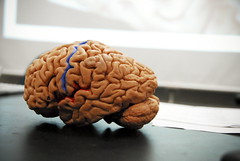In my freshman writing class (I think), we read this really amazing autobiography by a man who began a French Resistance group as a teenager in WWII. After a few years, the Gestapo found him and he was sent to a concentration camp for nearly two years. But his story was more than just a story of survival—he was unique not because he survived, but how.
The how is kind of hard to explain, but the basic reason was because saw a type of “light” within his mind that allowed him to discern about people and situations. If he heeded the guidance from that divine light, he was always able to find a way through difficult times.
 And the biggest reason he was able to be in tune with this light? He was blind. Being blind also helped him to develop his other senses to compensate, so his hearing was sharper than others’, etc.
And the biggest reason he was able to be in tune with this light? He was blind. Being blind also helped him to develop his other senses to compensate, so his hearing was sharper than others’, etc.
Our characters’ senses can be their strengths—but they can also be their crutches (or ours!). Especially when we’re trying to focus on non-dominant senses (i.e. taste, smell and touch), one way to bring these senses out is to deprive our character of other senses in the long term or short term.
You might try this as just a writing exercise, or as a scene to use, but here are just a few reasons a character might lose a sense for a time:
- It’s dark.
- He’s blindfolded.
- Close-range loud noise (gunshot, anyone?)
- She has a cold. (That can affect smell, taste and hearing. Oh the joys.)
- Medical procedure, such as eye surgery.
- She’s wearing hearing protection, ear plugs or even earmuffs.
- Shock.
- He lost his glasses or contacts. (I’d be legally blind without mine.)
You can rewrite an old scene or create a new one where your character doesn’t have access to the full range of senses. If you deprive your character of a dominant sense (sight or hearing), how will her other senses compensate? Does she listen for his tone more carefully or is he especially attuned to the scent of her perfume?
This is an idea I had while writing this series, but it’s not something I’ve had time to try yet. So if you’re up for it, let us know how it goes!
What do you think? How else would senses compensate for a lots one? How might a character temporarily lose one or more senses?
Photo by Mirko Tobias Schaefer

